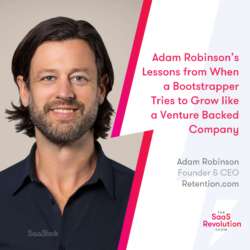This article was originally published in the SaaStock Blueprint newsletter. Subscribe to join thousands of founders and get insights like this, right to your inbox.
In investors’ eyes, Net Revenue Retention (NRR) is the ‘most important’ SaaS metric.
And you can see why—an NRR of +100% tells them that your business can grow without relying on new customer acquisition.
Last year, median SaaS NRR was 110% with top performers achieving 120-130%. So how and when should you implement retention strategies to boost NRR?
At SaaStock USA, Xero CRO Ashley Grech highlighted five key moments that really matter for retention:
- First impressions
- Conversion
- Establishment
- Growth
- When something goes wrong
Her approach is to think deeply about these moments and continuously test retention strategies for each of them. In doing so, Ashley has previously doubled conversion rates and increased NRR by 20%.
Here are the highlights from the conversation.
The 5 key retention moments
1. First impressions
Think about when prospects land on your website.
- How many clicks does it take to reach the information they need?
- How long do they spend on the site?
- What are the differences for mobile and desktop users?
- Are you using language that resonates with them (versus what resonates with you as the maker of the product)?
2. Conversion
Think about how customers choose to sign up.
- If you have a PLG motion, how long does it take for customers to get active?
- If you’re sales-led or product-led sales, are you introducing the salesperson (your most valuable asset) at exactly the right moment?
3. Establishment
Sign-up is just a commitment to try your product (you can’t call them a customer until they’re actively using it), so think about what ‘establishes’ them as a customer.
- Ask yourself as a company: if someone leaves within 90 days of signing up, do you call that churn or an establishment issue?
- Establishment issues are a potentially easier fix, so analyse why they left and ask yourself: what intervention or adjustment could smooth the establishment process?
4. Growth
Think about growing accounts through cross-sells or upsells.
- Are you deploying your best assets (your humans) in the best possible way?
- What elements of life cycle marketing should be automated versus human?
- Is your customer service team reaching out at the key moments?
5. When something goes wrong
Think about what happens when something goes wrong, such as charging them twice or a recent outage.
- How do you handle that as a company from a policy and process standpoint?
- Can you instantly rectify the issue and offer support (i.e. like an airline immediately rebooking you on the next flight after a delay)?
Test, test, test
To get the ball rolling, Ashley advises to pick one or two of the five movements to focus on, and then test and iterate retention strategies for those moments.
“Don’t wait to test. My greatest career regrets are waiting too long to test and believing that either it would disrupt something or that testing was something you did when times were slower. But testing in peace time will help in wartime, no question.”
Ashley recommends using insights from internal customer data – both qualitative (i.e. customer feedback) and quantitative (i.e. usage data clicks and payment transaction volume) – when deploying retention strategies. For example:
Test at the moment of conversion
If your product requires users to take a few steps to get live (i.e. input a menu, import their inventory or attach a bank feed), first try to shorten the number of steps where possible. Then, make each step easier to complete by intercepting the process with human outreach.
For example, if it’s been seven days since sign-up and the user has not uploaded the required data, offer to help them with onboarding either for free or for $100 assisted on-boarding. Ashley implemented this approach at one company and it doubled conversion.
Test at the moment of growth
Divide account data into positive and negative heuristics and instruct your customer team to reach out (via email, phone or even just an automated message) at key moments to offer support. For example:
- Positive signal: Customer adds more users. Reach out saying: ‘I’ve noticed you’ve added more users. Did you know that we have an employee management feature or payroll product that could help…’
- Negative signal: Customer suffers a recent outage. Reach out saying: ‘I noticed you were recently impacted by our outage, if there’s anything we can do to help get your business up and running again, I’m here for you…’
By catching a business on their upswing or supporting them when things are difficult, Ashley managed to increase NRR by 20% (and by only reaching customers 50% of the time).
Test at cancellation too
Cancellation is also a great time to test retention strategies as you have little to lose and much to gain.
According to Guy Marion, CMO at Chargebee (former Co-founder and CEO of Brightback), “cancellation is the most valuable moment in the customer lifecycle rivaled only by the moment of purchase, but it’s a blindspot for most companies.”
Be it sending an exit survey to identify why they’re canceling or testing offers to bring back cancelling customers from the edge, cancellation is a great opportunity to gather data to improve your retention strategies elsewhere and boost your NRR.
Recommended reading
Read more form leading SaaS execs and investors on how to grow revenue and keep customer for longer:





